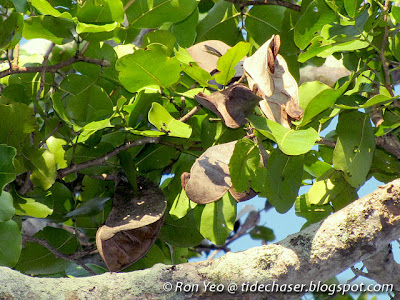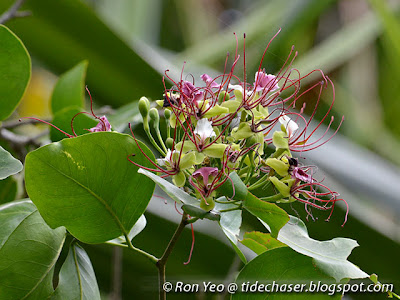I could still remember the first time I saw the Ipil tree along a tidal river on Pulau Tioman. At that time, I had no idea what tree it was, but it's such a tall and majestic tree, that I decided to take a photo of it. It's only after I came back to Singapore and did some research that I knew that this was an Ipil tree. Since then, I always kept a lookout for this tree when I visited our mangrove forests.
The Ipil (Intsia bijuga), also known as Moluccan Ironwood, is a mangrove associate from the legume family, Fabaceae. It's usually found at the drier areas of the mangrove forests or sandy beaches. This coastal/back mangrove tree is critically endangered in Singapore, and hence it's no surprise that I did not see many of them growing wild.
The tree has pinnately compound leaves, with 2-6 leaflets, though usually I see 4 leaflets only. It is deciduous, which explains why the ones near the Sungei Buloh Mangrove Boardwalk appear rather bare sometimes. This tree can grow to more than 40 m tall!
The flowers occur in dense clusters, and each flower has 4 sepals but only one petal, which starts off white in colour, but eventually turns to dark purple.
The fruit is a flat pod that turns brown as it matures - not quite sure how long it takes to mature though, but definitely more than a month from my observation.
The timber from this tree and other related Intsia species is known as "merbau" commercially, and is a high-end luxury wood, particularly popular for hardwood flooring but also used to produce furniture and musical instruments. The reddish-brown timber contains yellow specks, making it appears to be ""gold-flecked", and making it very popular with the Chinese. The locals use the wood to build houses, bridges, and boats, as it is very durable and resistant to insects and weather.
Rather unfortunately, the high demand for the timber has led to over-logging, both legally and illegally, and only small pockets of Ipil remain in Southeast Asia. It is believed that the only commercially viable population is found on the island New Guinea. Apparently, the IUCN’s Red List of Threatened Species 2006 has categorised merbau as "facing a high risk of extinction in the wild in the near future".
Apart from being an important source of the merbau timber, the bark and leaves of the Ipil is also used as medicine to treat diarrhoea. The seeds are also edible. They are usually fried, soaked for a few days, then boiled and eaten.
On mainland Singapore, the biggest population of Ipil that I had seen so far occurs in the mangrove forest near Kranji Nature Trail - there were at least 2 mature trees, and perhaps more than 10 young ones. I had also seen a few trees at Mandai Mangrove, Sungei Buloh, Admiralty Park and Seletar Mangrove. Would assume it could probably be found at Khatib Bongsu and Lim Chu Kang as well, though I hadn't properly explored these areas yet.
Offshore, the biggest Ipil population could be found on Pulau Tekong, and I had also seen a few trees on Pulau Ubin. I certainly hope to encounter more of them as I explore more of our mangrove forests :)
The Ipil was also planted in several parks and gardens, and I had seen a few mature trees in the Singapore Botanic Gardens, and a few young ones along Sentosa Boardwalk and in Labrador Park
References
- Cheung, S. P., C. Tiy & T. Stark. 2007. Merbau’s last stand: how industrial logging is driving the destruction of the paradise forests of Asia Pacific. Greenpeace International. Amsterdam. 34 pp.
- Chong, K. Y., H. T. W. Tan & R. T. Corlett, 2009. A Checklist of the Total Vascular Plant Flora of Singapore: Native, Naturalised and Cultivated Species. Raffles Museum of Biodiversity Research, National University of Singapore. Singapore. 273 pp.
- Giesen, W., S. Wulffraat, M. Zieren & L. Scholten. 2006. Mangrove guidebook for Southeast Asia. RAP Publication 2006/07. FAO Regional Office for Asia and the Pacific & Wetlands International. Bangkok. 769 pp.
- Ng, P. K. L., and N. Sivasothi. 1999. A guide to the mangroves of Singapore 1 : the ecosystem & plant diversity. Singapore Science Centre. Singapore. 168 pp.

4 comments:
Fascinating. Do you know if the seeds of this tree are dispersed by water? And if so, do they occur elsewhere in Asia?
Hi! I can't seem to find any information on their dispersal agent, but would assume that the seeds are dispersed by water since they have a thick and hard seed coat that prevents water from entering the seed. It is very widely distributed - from Madagascar all the way through tropical Asia to northern Australia.
Hi, you can also find Intsia at Admiralty Park nature area. They are fruiting trees.
Hi Anonymous,
Yup. Have already mentioned this in the above entry actually :P
Thanks :)
Post a Comment